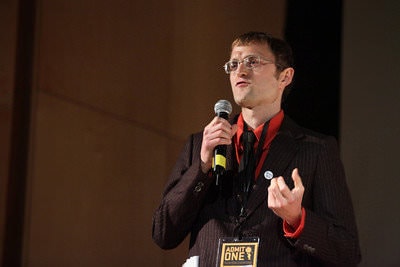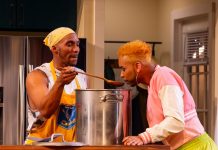The 15th annual Maryland Film Festival will be taking place this weekend. MFF Director of Programming Eric Hatch updates us on some selections that were made in Maryland and the surrounding DC/Northern Virgina areas:
12 O’Clock Boys
I Used to Be Darker
Hit & Stay
White Reindeer
V/H/S/2 (this is a horror film comprised of several shorts from all over the world, one of which was shot in Frederick by Blair Witch Project co-director Eduardo Sanchez).
Other selections are feature documentaries about Baltimore-specific topics:
I Am Divine (about John Waters music/drag diva Divine).
If We Shout Loud Enough (about the last tour of Baltimore post-punk band Double Dagger).This documentary is about a New Orleans gospel band, but both directors are Baltimore-based:
By and By
This documentary was initiated and produced by a Catonsville-based filmmaker:
Good Ol’ Freda
Also, among our 80 or so short films, several are by Baltimore-based filmmakers: Karen Yasinsky (we’re showing 2 of hers), Alan Resnick (we’re showing 3 of his), Phil Davis, and Lorenzo Gattorna.
What are your responsibilities at The Maryland Film Festival? Take us behind the scenes of the film selection process.

Eric: I’ve been one of the two staff programmers at Maryland Film Festival since 2007, and became the Director of Programming in 2010. I oversee the selection process for the films we screen during our annual festival weekend each May, as well as implement our year-round programming such as the film components of Artscape and our popular Gunky’s Basement film series. For each of our annual festivals, I direct the process of selecting from all the films in front of us the approximately 50 features and 10 shorts programs we deliver to audiences. This entails managing our call for entries, curating and coordinating the screening committee that evaluates entries, staying connected to filmmaker alum and staying on top of their emerging work, and pursuing films that myself and other MFF programmers have seen at other festivals such as Sundance, Toronto, SXSW, and Slamdance.
This will be my seventh festival; before this, I had ten years’ experience as a film and music critic for Baltimore City Paper, and created, curated, and hosted a free film series at the Baltimore Museum of Art.
What do you look for when screening potential films?
There’s no magic formula. Generally we look for production values that go beyond the competent and the professional into the realm of the inspired. That said, there are times when a film’s originality, humor, and/or raw energy can overcome some technical rough edges. I find that a lot of the most original films of the last few years have been in genre filmmaking, so often one doesn’t have to choose between genre and originality these days.
Our motto is “Film for Everyone,” and our mission is to broaden the number and variety of voices and visions moviegoers come into contact with. We know that there are hundreds of worthy films each year that don’t make it to Baltimore for theatrical runs, as well as large audiences here hungry for more film diversity than is available in this under-screened city on an average day. We’re trying to fill those gaps.
Do you have a favorite film category at the festival?
We show our films without categories, except for distinguishing between features and shorts in our program, and linking the shorts programs thematically (“Animated Shorts,” “Documentary Shorts,” etc). Our features are presented without category, simply listed alphabetically in our program. We feel that categories often deter audience members from taking chances on a film because they don’t look past the label (“Experimental Film,” “Local Film,” etc). Instead, we hope audience members will read our program notes about our line-up, watch trailers, and get a fuller sense of which films most appeal to them.
That said, we do have recurring events each year: a favorite film selected and hosted by John Waters; a vintage 35mm 3-D film; a silent film presented with live music by Alloy Orchestra; and a guest-host program in which a person best-known for work outside the world of film selects and hosts a favorite movie (in past years these have included musicians such as Dan Deacon, Will Oldham, Branford Marsalis, Ian MacKaye, and Jonathan Richman).
I’ve noticed that some larger scale production and bigger name productions are making their way into smaller festivals. How do you ensure that MDFF stays indie friendly while showcasing selections you are drawn to?
Key to our mission is bringing in one or more filmmakers to represent each North American feature that we screen. This is typically the director, but can also be stars, documentary subjects, screenwriters, cinematographers, etc. We also, unlike many festivals, present our line-up in a non-competition spirit; films are not up against each other for any awards, whether jury- or audience-based. This creates a community atmosphere where filmmakers are connecting with each other and their audiences in a relaxed, mutually supportive manner. Most higher-profile filmmakers have embraced this community spirit as much as most filmmakers here with their first film. We’ve also kept our ticket prices low, offering audiences a film presented by its filmmaker for a lower price than they pay for just a film at many multiplexes, and offer many free panels and related events in our Tent Village, all in the name of creating a fun, accessible, and culturally enriching weekend.
Do you ever notice any yearly trends or themes when viewing screeners like more romantic films submitted than action films, or more comedies than dramas?
There are often waves of entries that are made in response to popular phenomenon of a few years prior, given how long it takes to make a film. For instance, when I started with the festival in 2007, we would see a lot of entries that seemed to be inspired by The Sopranos or Old School, and now we’re more likely to see entries inspired by the so-called mumblecore movement that has been very popular on the festival circuit.
When selecting documentaries – what do you look for?
[We look for] unique subject matter, compelling content, and a strong creative voice in how the film is crafted.
What can attendees expect at this year’s fest?
We’re growing to five days this year, extending from Wednesday, May 8 through Sunday, May 12 (in prior years we’ve run Thursday through Sunday). We may also add an additional screen. We’re taking these growth steps in response to the 2012 festival, which saw us only break all our records for both entries received and tickets sold. This will result in a small boost in the number of films we screen, as well as more second and third screenings of some features and shorts programs.
What are your hopes for the future of MDFF?
We’re working toward having our own venue 365 days a year. Baltimore needs a year-round, non-profit film center that can program both new and repertory films based on cultural value rather than each film’s perceived marketability.
How can the community get involved?
Everyone should consider supporting us by becoming a Friend of The Festival, our year-round membership support group that receives many benefits at our screenings both within our festival weekend and year-round. Those interested in volunteering should check our web site for more information (this information will probably not go live until a bit closer to our festival dates).





